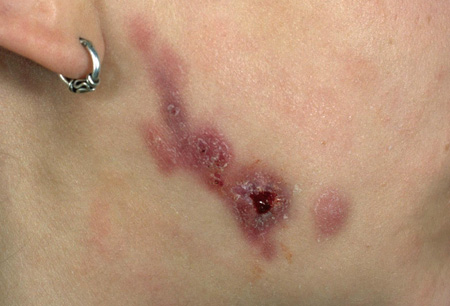Summary
Definition
History and exam
Key diagnostic factors
- soft-tissue swelling
Other diagnostic factors
- multiple sinuses
- skin discoloration
- chewing difficulties
- constitutional symptoms
- change in bowel habits
- abdominal discomfort
- nausea and vomiting
- sensation of abdominal mass
- vaginal bleeding or discharge
- dry or productive cough
- blood-streaked sputum
- shortness of breath
- chest pain
- focal neurologic defects
Risk factors
- male sex
- injury or inflammation of the oral cavity
- diabetes mellitus
- immunosuppression
- local tissue damage by neoplasia, trauma, or irradiation
- intrauterine device
- aspiration
Diagnostic tests
1st tests to order
- culture of pus or affected tissue
- histology of affected tissue
- immunohistology
- CBC
- CT or MRI of abdomen
Emerging tests
- PCR of affected tissue
Treatment algorithm
non-penicillin allergic
penicillin allergic
Contributors
Authors
Thomas Schneider, MD, PhD
Professor
Medical Department I
Charité - University Medicine Berlin
CBF
Berlin
Germany
Disclosures
TS is an author of a number of references cited in this topic.
Verena Moos, PhD
Scientist
Medical Department I
Charité - University Medicine Berlin
CBF
Berlin
Germany
Disclosures
VM is an author of a number of references cited in this topic.
Peer reviewers
Johannes R. Bogner, MD
Professor of Internal Medicine
Department of Infectious Diseases
Medical Polyclinic
University Hospital Munich
Munich
Germany
Disclosures
JRB declares that he has no competing interests.
Chris Huston, MD
Assistant Professor of Medicine
Division of Infectious Diseases
University of Vermont
Burlington
VT
Divulgaciones
CH declares that he has no competing interests.
Agradecimiento de los revisores por pares
Los temas de BMJ Best Practice se actualizan de forma continua de acuerdo con los desarrollos en la evidencia y en las guías. Los revisores por pares listados aquí han revisado el contenido al menos una vez durante la historia del tema.
Divulgaciones
Las afiliaciones y divulgaciones de los revisores por pares se refieren al momento de la revisión.
Referencias
Artículos principales
Smego RA Jr, Foglia G. Actinomycosis. Clin Infect Dis. 1998 Jun;26(6):1255-61. Resumen
Acevedo F, Baudrand R, Letelier LM, et al. Actinomycosis: a great pretender: case reports of unusual presentations and a review of the literature. Int J Infect Dis. 2008 Jul;12(4):358-62. Resumen
Wong VK, Turmezei TD, Weston VC. Actinomycosis. BMJ. 2011 Oct 11;343:d6099. Resumen
Martin MV. The use of oral amoxycillin for the treatment of actinomycosis: a clinical and in vitro study. Br Dent J. 1984 Apr 7;156(7):252-4. Resumen
Spilsbury BW, Johnstone FR. The clinical course of actinomycotic infections: a report of 14 cases. Can J Surg. 1962 Jan;5:33-48. Resumen
Sudhakar SS, Ross JJ. Short-term treatment of actinomycosis: two cases and a review. Clin Infect Dis. 2004 Feb 1;38(3):444-7.Texto completo Resumen
Bennhoff DF. Actinomycosis: diagnostic and therapeutic considerations and a review of 32 cases. Laryngoscope. 1984 Sep;94(9):1198-217. Resumen
Artículos de referencia
Una lista completa de las fuentes a las que se hace referencia en este tema está disponible para los usuarios con acceso a todo BMJ Best Practice.

Diferenciales
- Abdominal abscess
- Ovarian or oviductal tumor
- Appendicitis
Más DiferencialesInicie sesión o suscríbase para acceder a todo el BMJ Best Practice
El uso de este contenido está sujeto a nuestra cláusula de exención de responsabilidad